Hibachi fried rice is a buttery Japanese egg fried dish tossed in high heat. The word 'hibachi' in Japanese translates to fire bowl, and the description is apt as this dish is made with a covered bowl and high heat.
We fell in love with this dish when we first tried it in an Izakaya (Japanese pub). Since then, we have explored various recipes to find out how to make Hibachi fried rice.
Here's our recipe that got us closest to what we had in Japan. Our version is basic but perfect for you to build on by adding different veggies and protein. Making homemade fried rice, or chahan in Japanese, grants you an excellent chance to customise your meal.
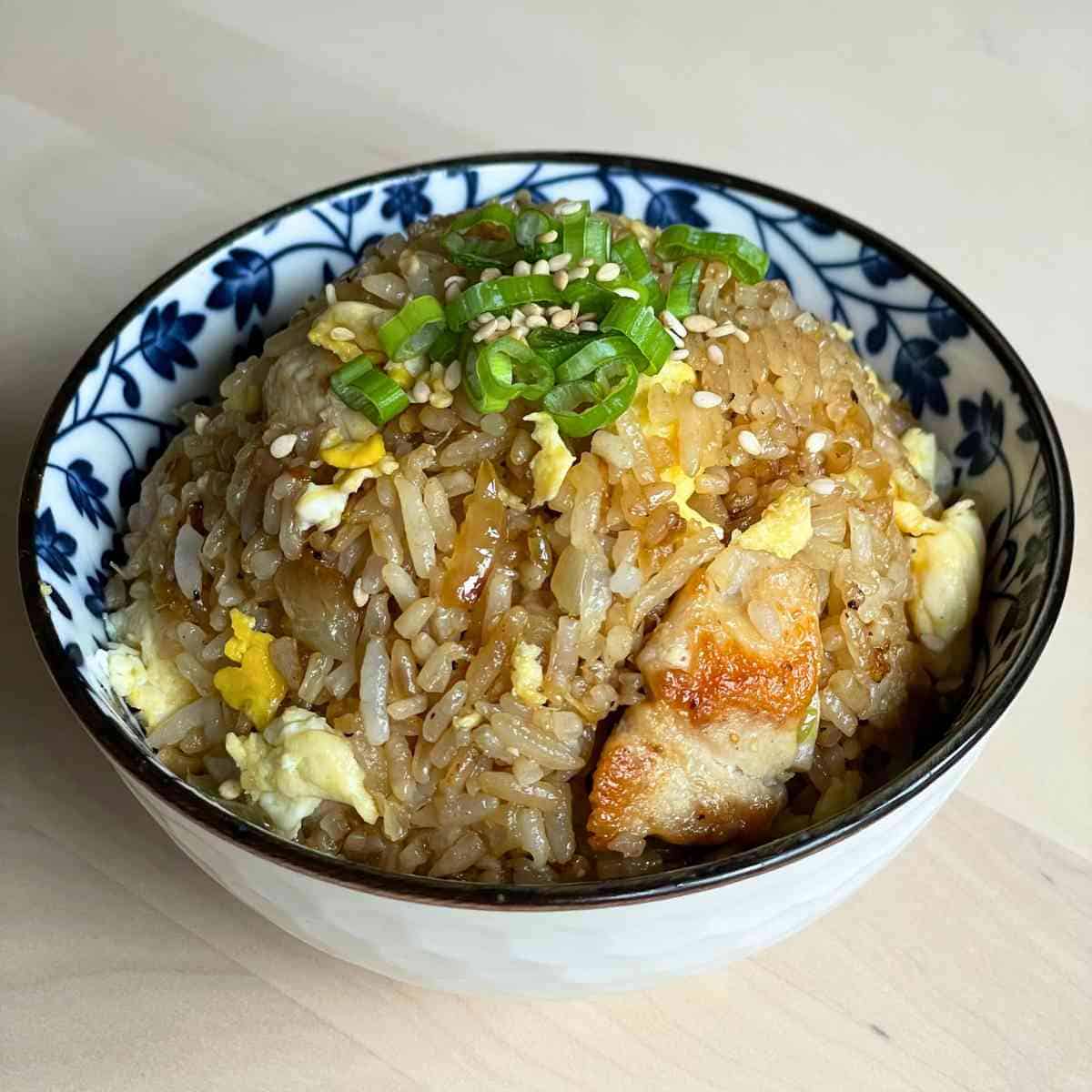
Jump to:
Hibachi Fried Rice Ingredients
To make this delicious dish, you will need the following ingredients:
- Leftover rice
- Butter (an essential ingredient)
- Eggs
- Onions
- Ginger
- Garlic
- Soy sauce
- Salt and pepper
- Vegetable oil for frying
- Sesame oil for glazing (optional)
- Spring onions (green part only - for garnishing)
- Shichimi togarashi (optional)
- Ajinomoto MSG (optional)
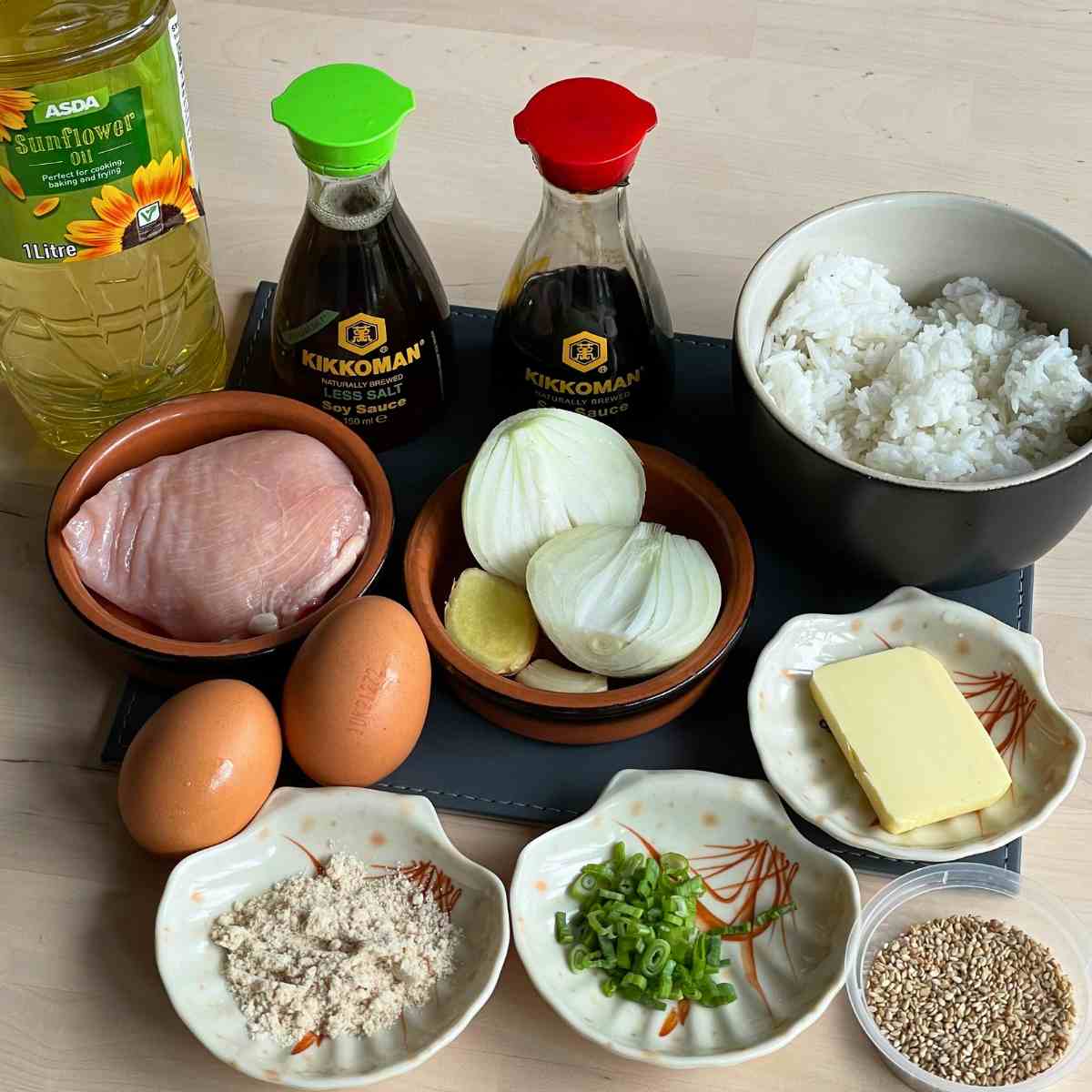
Rice Grain
For our recipe, you will need short Japanese grains, the same variety used for sushi. We like using cooked leftover rice that has been cooled overnight, as the dry day-old grains tend to hold their shape better when fried.
Otherwise, you can also use long-grain varieties such as Jasmine or brown, which are much easier to find in grocery stores. However, long-grain varieties are firmer in texture when you cook them.
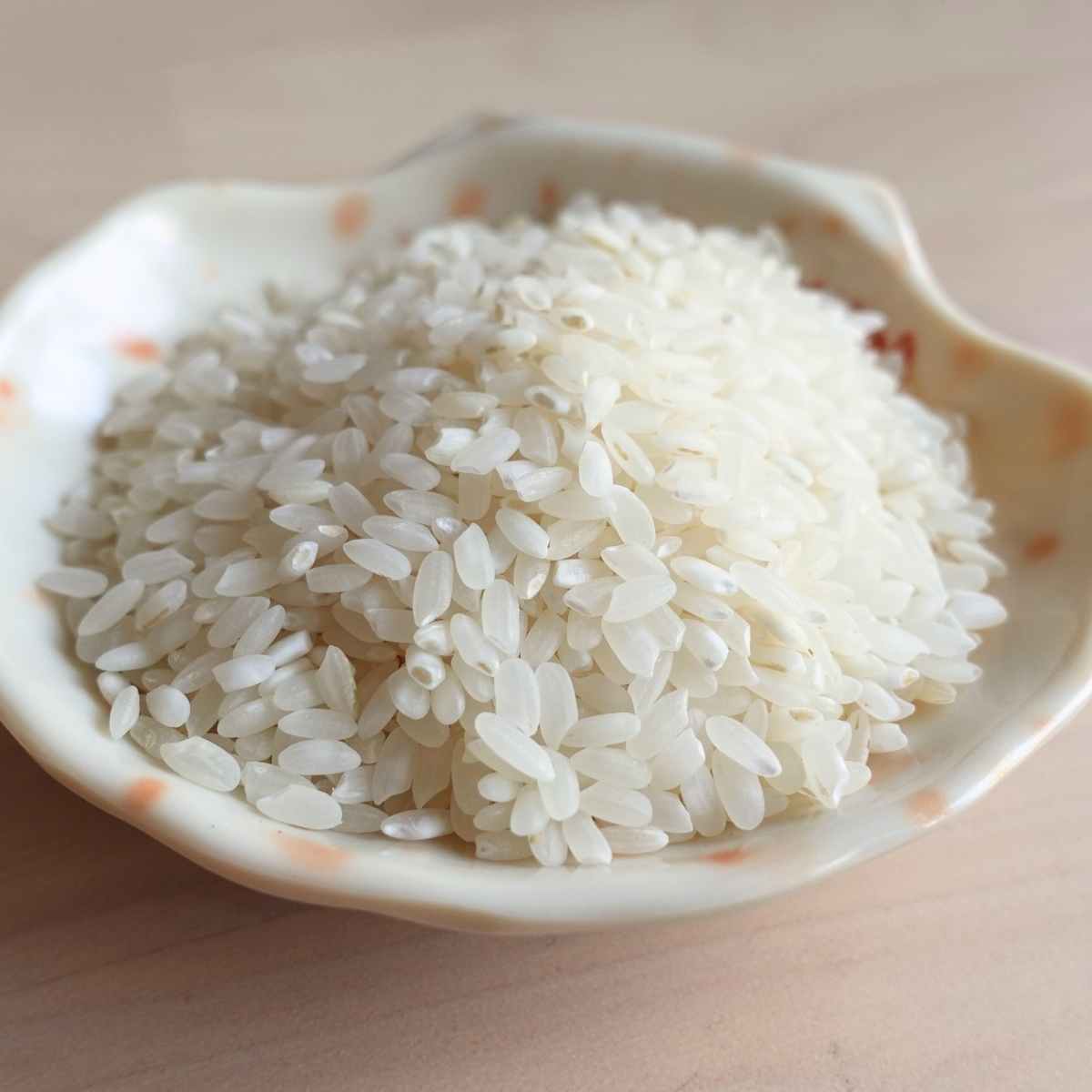
Vegetables
Onions and ginger are usually included in this dish. A lot of onions add a bit of savoury sweetness to this fried dish, while ginger and garlic make a delicious umami base for the fried dish.
From memory, many Hibachi fried rice dishes in Japan don't include many vegetables, and if they do, it's just carrots and peas. This dish is usually served as a side dish in Izakayas. So, you can always add carrots and peas if you need more fibre.
Baby mushrooms, bell peppers, and green zucchini are great when fried and add a burst of flavour. However, we don't recommend adding leafy vegetables, as they are much more challenging to fry and can overwhelm the dish. If you really want to add these, be sure to slice the vegetables into smaller strips for cooking. We recommend green beans or cabbage.
Meat (optional)
Meat is not a must in our recipe, as Japanese fried rice is usually served with other side dishes. But if you do see it in restaurants, it's usually shrimp, chicken, or pork.
While the shrimp are usually included as whole shrimp, chicken and pork are usually cut into small bite-sized pieces.
For our recipe, we added chicken breasts that we cut into small ½ inch pieces. Then, we seasoned them with salt and sansho (Japanese green peppers) and pan-fried them to later mix with the fried rice. You can also use chicken thighs and cook them at high heat.
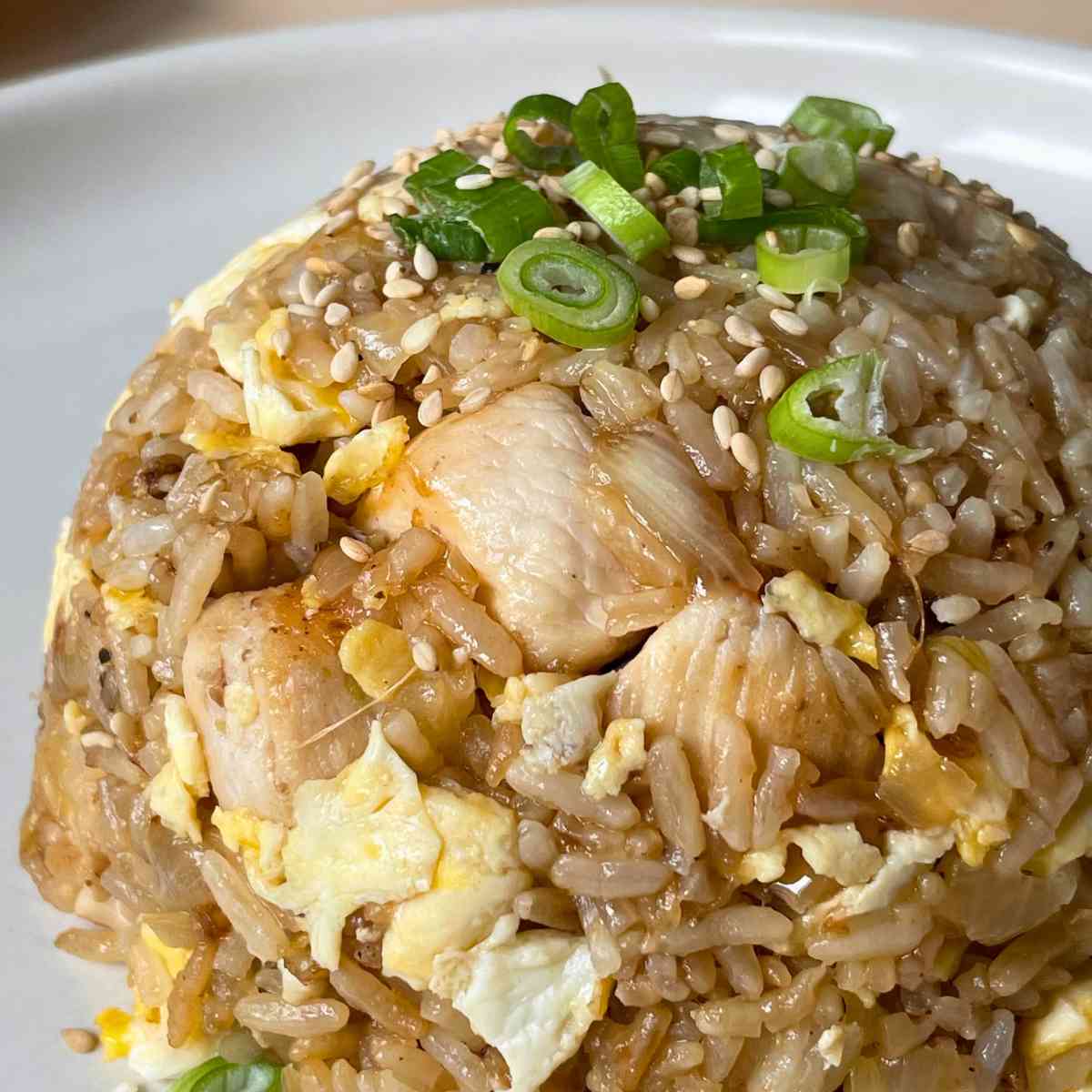
If you're adding shrimp, remove the tails and shells. Make sure they are also deveined. Thaw and pat the shrimp dry before grilling them with the chahan.
Similarly, you could use a strip steak such as sirloin. Strip steaks have more marbling, and the fat will caramelise when you fry it. Also, the juices that ooze out from the tender meat will make your Hibachi fried rice dish oh-so fragrant.
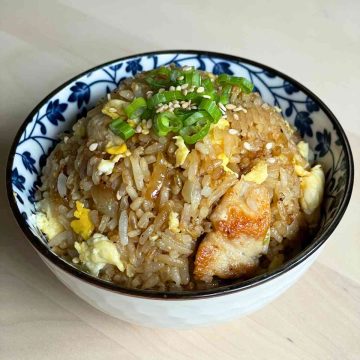
Hibachi Fried Rice Recipe
Ingredients
- 2 cups Japanese rice day old, short grained, cooked
- 1 tablespoon vegetable oil
- 1 tablespoon butter
- 2 large Eggs lightly beaten
- 1 onion diced
- 1 inch ginger grated
- 1 clove garlic grated
- 2 tablespoon light soy sauce
- 1 teaspoon sesame oil
- 1 spring onion green part only, thinly sliced for garnish
Instructions
- Heat a large wok over medium-high heat. Add the oil to the pan. Once the oil is hot, add the eggs to the pan. Scramble them in the pan. If you're adding meat, do the same as the eggs. But fry your meat first, then put aside. Remove and set aside for later.
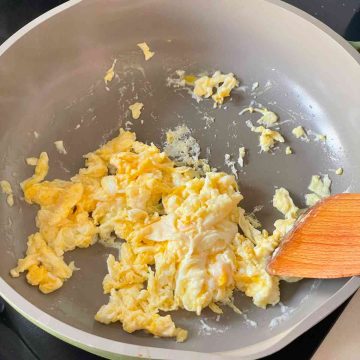
- Lower the heat to a low heat, add the butter to the pan and let it melt. Once melted, increase the heat to medium-high heat, Add the onions, grated ginger and grated garlic and cook for 1 minute or until wilted fragrant. Add cooked rice and stir fry for 2 minutes. Then, pour the soy sauce over the grains and stir fry for 1 more minute to mix well. Then, add the scrambled eggs (and fried chicken) to the pan and stir fry for another 1 to 2 minutes. Once the short grains start to char slightly, it's done.
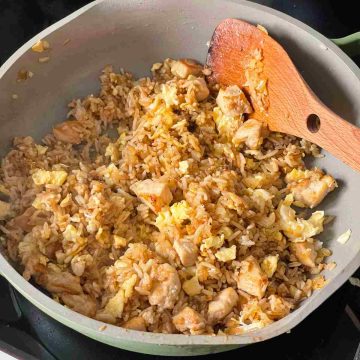
- Finally, drizzle the sesame oil over the fried rice and mix it one final time. Serve it on plates or bowls and garnish with spring onions and sesame seeds.
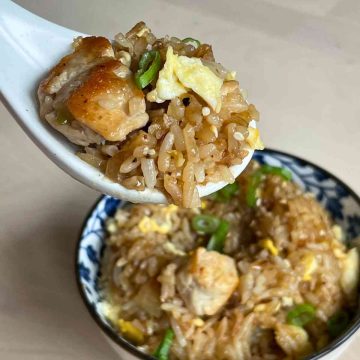
Notes
Nutrition
Calories have been calculated using an online calculator. Nutritional information offered on Honest Food Talks is for general information purposes and is only a rough estimate.
Hibachi Fried Rice Seasoning
Seasoning for Hibachi fried rice is very simple. Most of the flavour comes from the butter, which adds a rich and luxurious taste. The onions, garlic, and ginger provide a savoury base, while soy sauce adds saltiness and umami. We've included sesame oil, which you drizzle over as a glazing at the end, giving it a nice nutty fragrance and a shine.
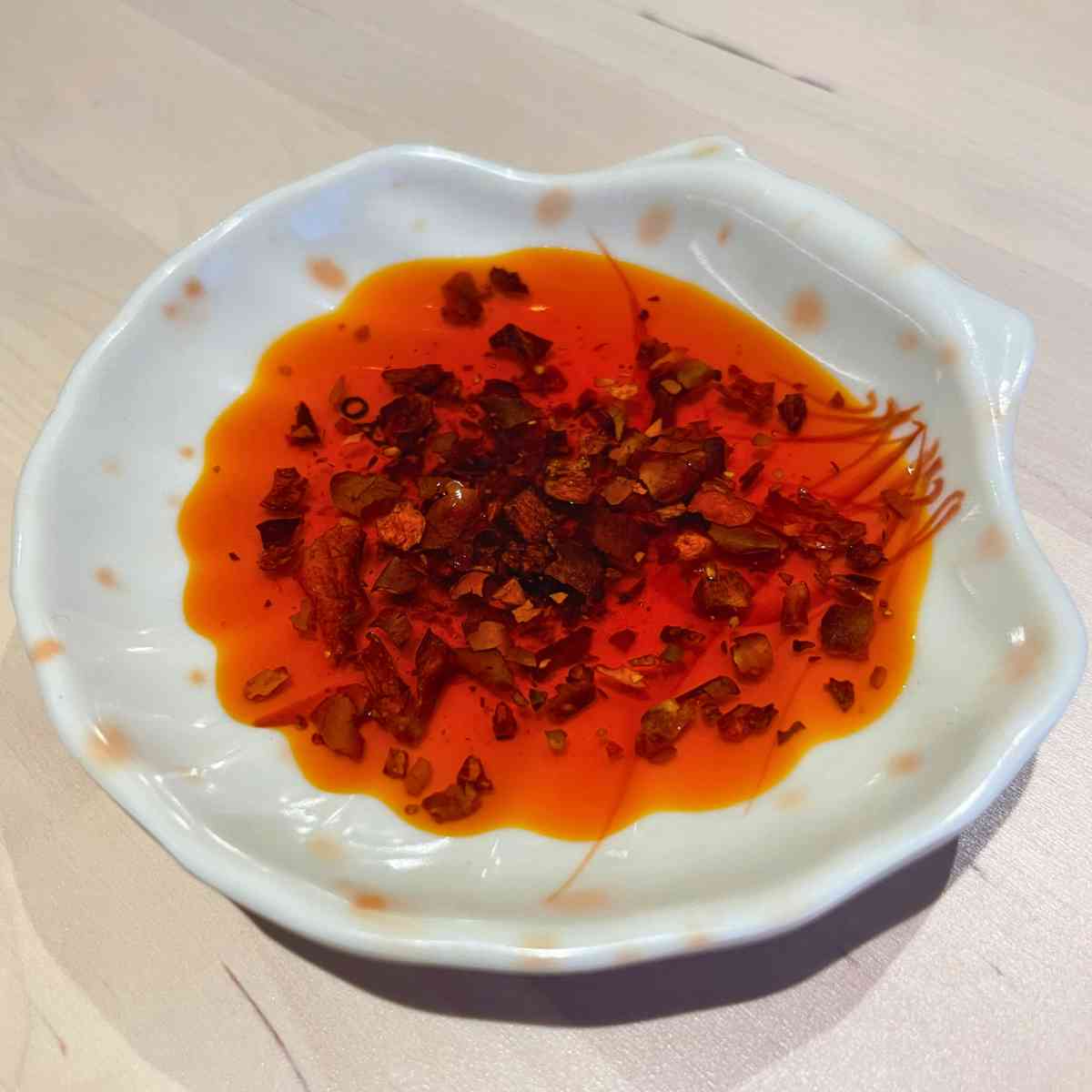
Usually, Japanese izakayas have a Shichimi togarashi (seven spices), which customers may use as an additional seasoning, but it's not essential. Shichimi togarashi adds a nice spice kick to the dish, so we recommend it to spice lovers.
Ajinomoto MSG is another common seasoning ingredient we find in other recipes. It certainly adds umami to the dish, but we personally don't usually use it. We find the base dish without MSG to be quite flavourful already.
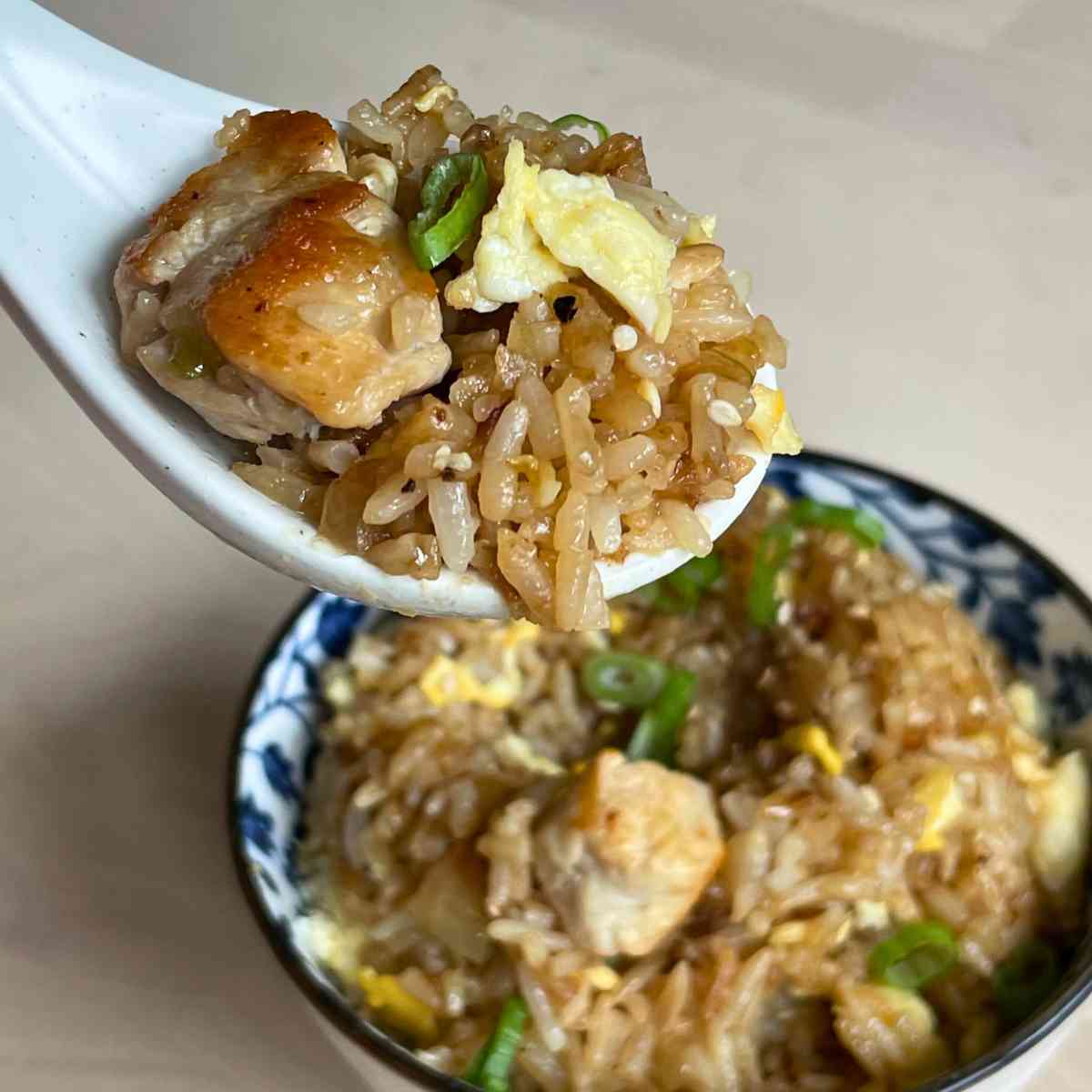
Tips on how to make Hibachi fried rice
If you want to know how to make Hibachi fried rice properly, follow these cooking tips to cook your chahan perfectly.
Why use day-old rice
Using day-old rice will also prevent the grains from clumping or turning sticky when you cook it. Leftover rice is generally better as it tends to be drier. Therefore it won't be as sticky or clumpy when you stir fry. You can still use freshly cooked grains, but we recommend drying them out for at least 1 hour before stir-frying.
Less butter
Although adding butter softens the grains and adds a richer taste, you might prefer a less creamy version. In that case, you can always put half the butter in our homemade Japanese egg-fried recipe. Make sure to use unsalted butter, too.
If you don't want to use butter, use neutral-tasting vegetable oil like canola or sunflower. It will lightly coat the grains and achieve the same effect as butter. However, you won't get the same fattiness and richness in your final dish without butter.
Avoid burning the grains
We recommend using a wok or a deep pan to avoid burning. Lower the heat when you're melting the butter, as it burns quickly under high heat. We want the butter to completely melt before mixing and stir-frying with the rest of the ingredients.
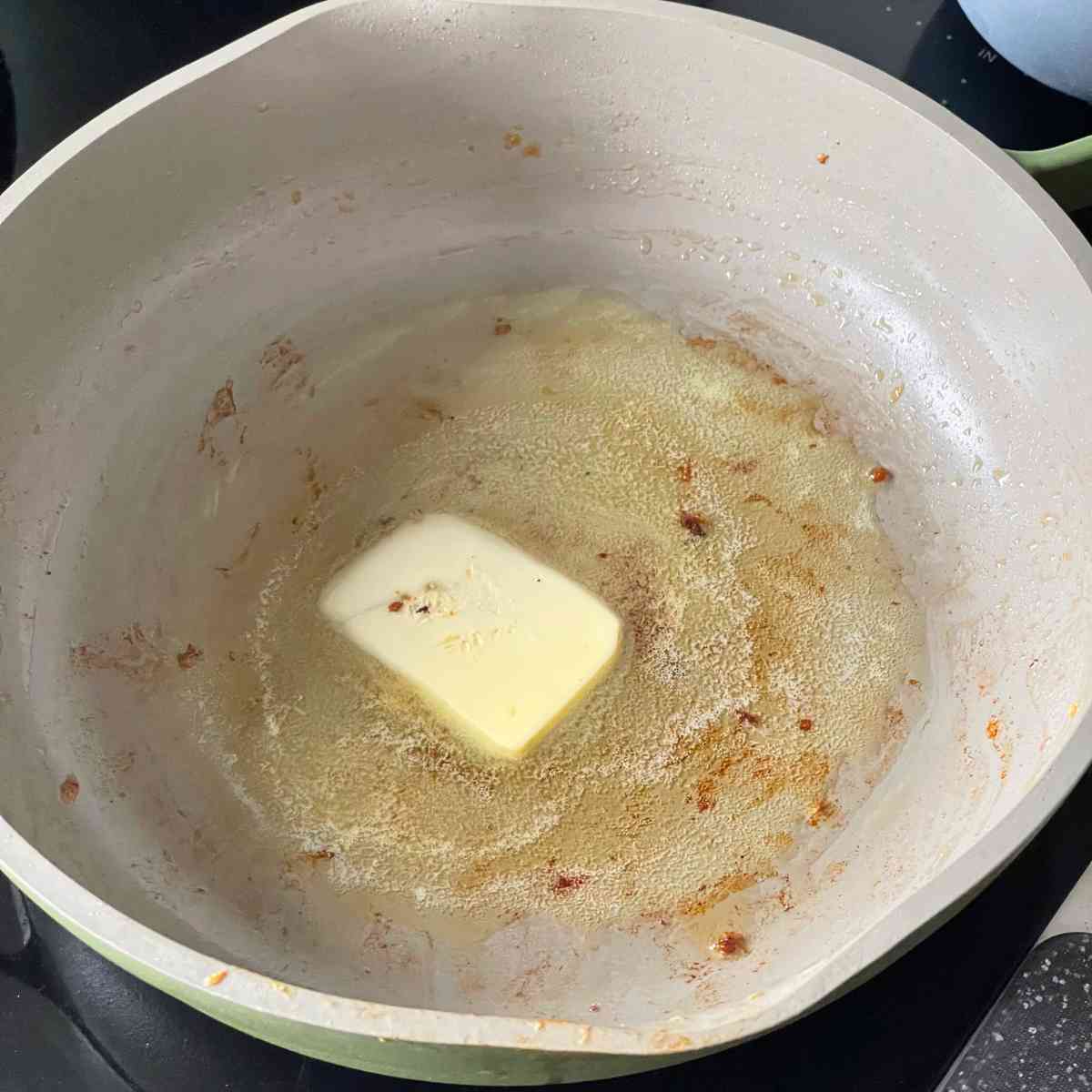
Keep moving the grains around if you use a frying pan or wok while making this dish. Spread oil evenly in the frying pan to avoid burning the short grains. Turn the stove to medium-high heat and cook once the wok or pan is hot. One way to know if the pan is hot enough is by seeing if the oil added can easily swirl around. However, avoid it being too hot that the oil starts smoking. At that point, unless you're an expert at quickly stir-frying, you risk burning your ingredients.
When the wok is hot enough, the grains cook better and will turn out fluffier.
You want to fry the Hibachi fried rice until the grains start to char slightly. The smokiness of the char or 'wok hey' is a great flavour enhancer that you should aim for when making fried dishes.
Preparing tender meat for fried rice
A regular serving of our Hibachi fried rice has about 800 calories without added chicken. If you want to add meat to your Hibachi fried rice, here are tips for the most tender meat cuts.
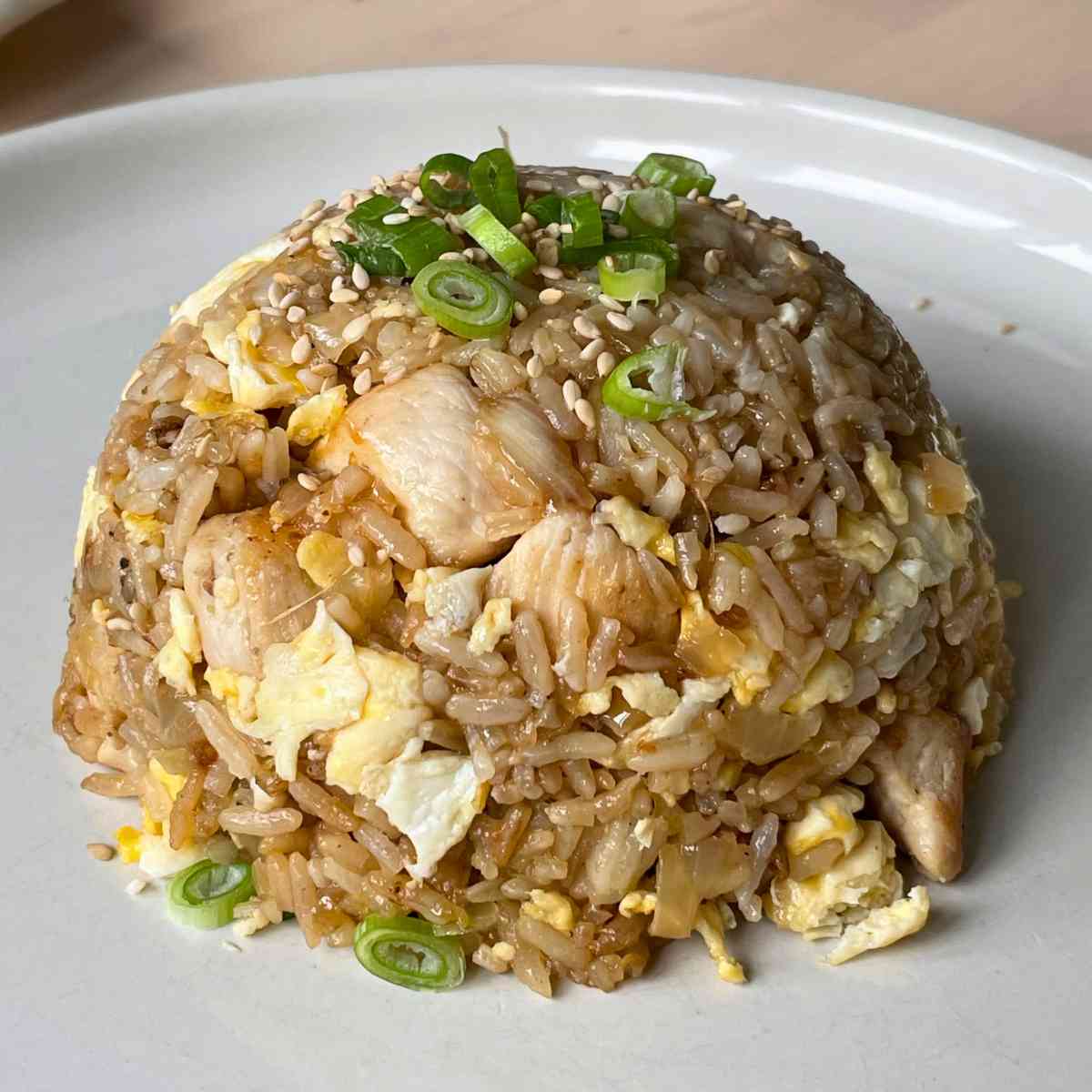
We usually season the cut chicken breast with salt and black pepper to keep it simple. For a more Japanese-like flavour, you can also use sansho (Japanese green pepper) to mimic the taste of yakitori. Season generously, and let it marinate for at least 30 minutes.
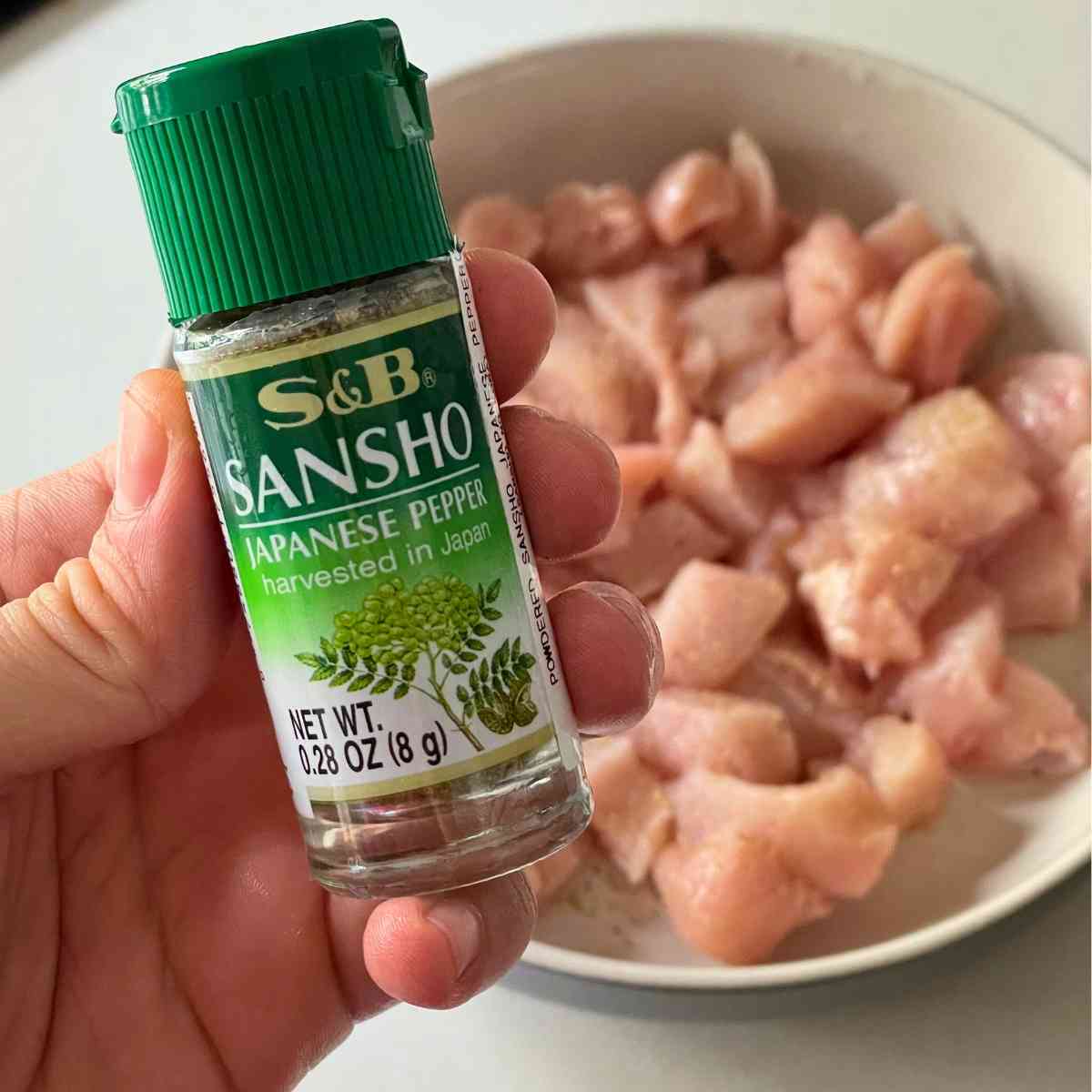
When you're ready to cook, heat the pan and add oil. Once the oil is hot, spread the chicken on the pan and let it fry for 5 to 7 minutes. Don't flip or stir fry the chicken at this point. You want the bottom side of the chicken to char nicely into a golden brown colour. Then, flip the chicken pieces and fry the other side for another 2 to 3 minutes. The surfaces of the chicken should be golden brown. Put them aside to mix in with the fried rice later.
How To Store
To store your Hibachi fried rice, let it cool down before storing it in a closed container and putting it in the fridge. Keep leftover portions of Hibachi fried rice frozen if you intend to keep it for over a day.
When ready, take it out and microwave it before cooking it. Ensure you heat it to at least 165 degrees Celsius for a few minutes to kill any bacteria and do not reheat the frozen leftovers more than once. Finishing leftovers in the refrigerator after 3-4 days is best. Although you can keep frozen cooked rice for up to three months, we do not recommend it, as these leftovers can cause food poisoning.
Vegan Version
If you're vegan and want to know how to make Hibachi fried rice without eggs, it's simple. For the flavour, include more peas and carrots. To substitute the smooth taste of eggs that hold the grains together, try scrambled silken tofu with a pinch of black salt. Additionally, use vegan butter instead of regular butter.
Teppanyaki Vs Hibachi
If you're wondering whether teppanyaki fried rice resembles Hibachi fried rice, the answer is no. The grilling equipment is entirely different. Teppanyaki grills are rectangular flat iron griddles above a heat source, usually electricity.
However, when you see Hibachi fried rice on a grill in a traditional Japanese restaurant, you will notice that it is cooked over charcoal on a shichirin. A shichirin is a small barbecue grill with an open-grate design on top. Japanese cooks place the food over the grill and heat it using charcoal on a stove.
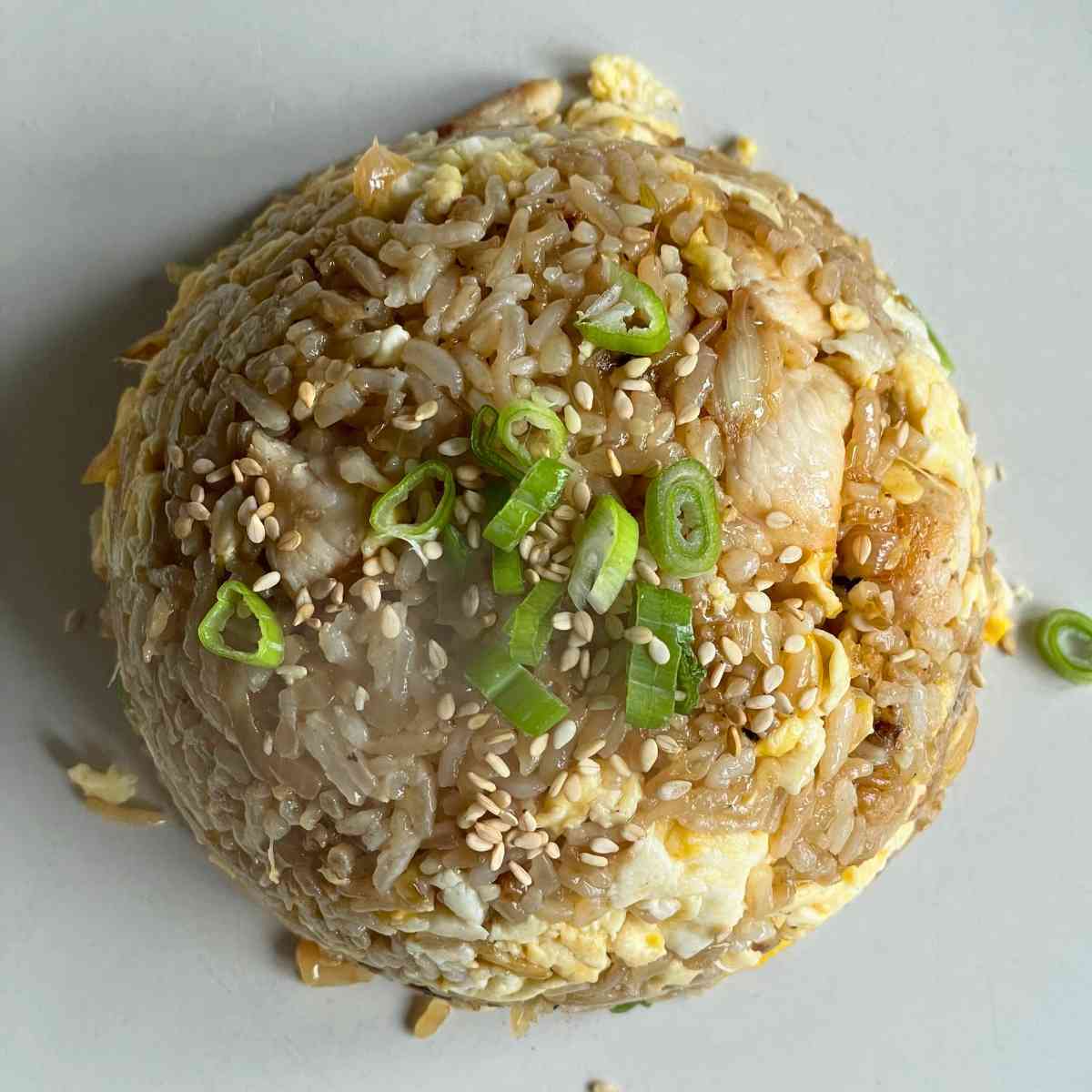
In many traditional Japanese restaurants, this dish is fried simply in a container made of wood or ceramic and lined with metal. However, teppanyaki cooking methods are usually a performative art form. Teppanyaki chefs use various cooking methods, such as tossing the grains in the air before frying them on the grill directly. Traditionally, there are also more meat options in Teppanyaki cooking.
Of course, with modern cooking methods, you can always use a Dutch oven, frying pan, or skillet to fry all the ingredients over high heat, not necessarily a shichirin.
Difference Between Chinese Fried Rice And Hibachi
The critical difference is that Hibachi fried rice is cooked in butter and oil, while the Chinese version consists of grains cooked only in oil.
You will also notice that the Japanese dish has fewer sauces than the Chinese version.
Another difference is the type of grain used. The Japanese version of this dish uses a short-grain variety, a common ingredient in sushi rolls. The short-grain variety tastes slightly stickier and chewier.
On the other hand, the Chinese version uses a long-grain variety, so you get a firmer bite without the glutinous taste of its Japanese counterpart.
If you've enjoyed our Hibachi fried rice recipe, subscribe to our YouTube Channel. There, you'll find more delightful, easy-to-make Asian food recipes and snacks, so you'll never have to rely on takeout again.

Leave a Reply